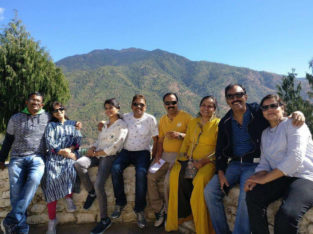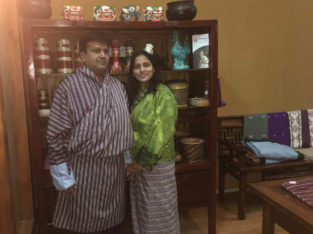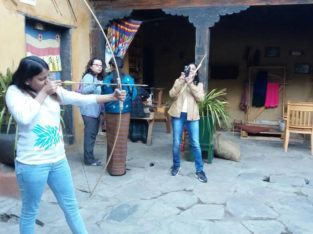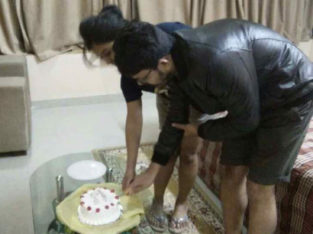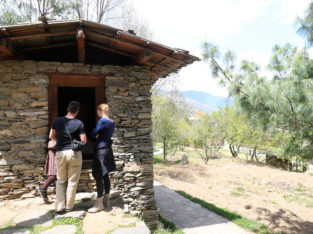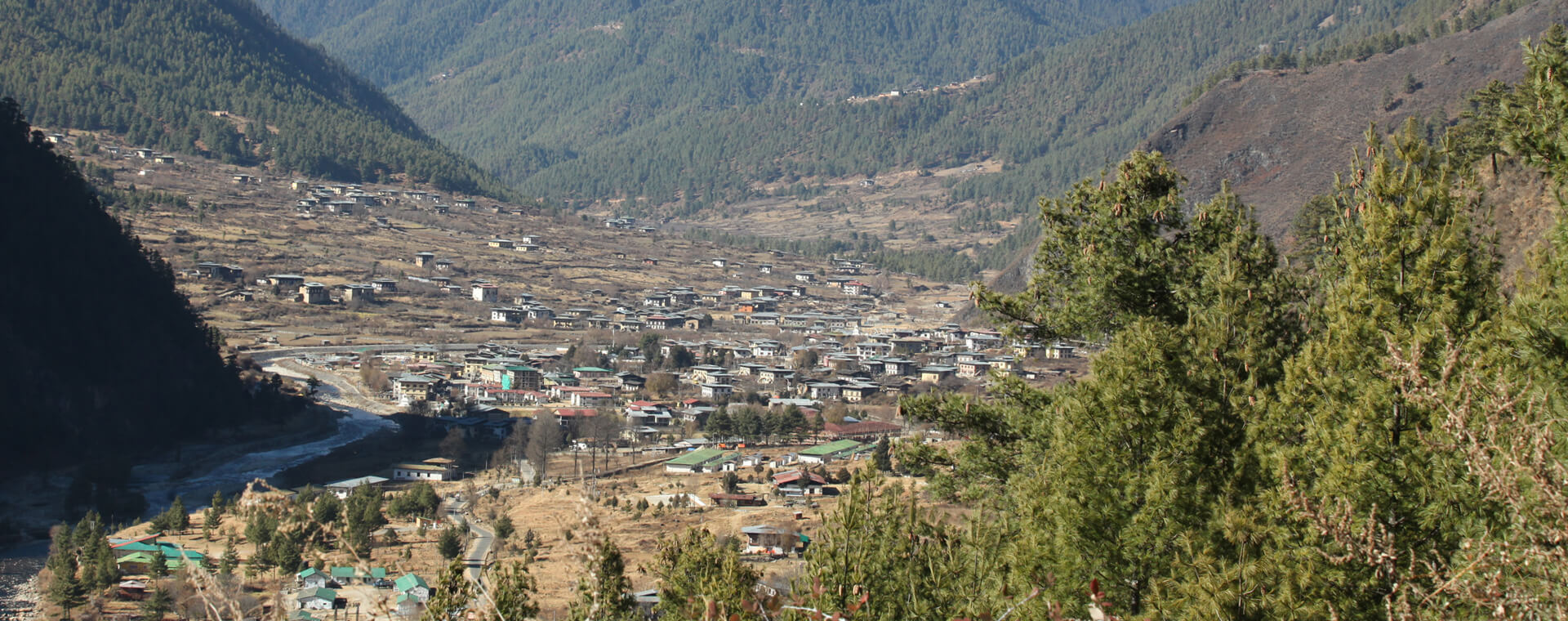Haa
Located in South West of Paro and covering an area of roughly 1706 sq. km. Haa is the smallest Dzongkhag in the country. This tiny region is one of the most beautiful and isolated areas in the kingdom, adorned with pristine alpine forests and tranquil mountain peaks.
Haa is the ancestral home of the Queen Grandmother and the illustrious Dorji family. This valley remains one of the least visited areas in the country and retains the air of an unspoiled, primeval forest. The wooded hills of Haa provides an ideal location for hiking and mountain biking. Biking around the valley to visit the dozen or so local temples is an enjoyable way to spend the day when visiting.
Haa is home to a number of nomadic herders and hosts an annual Summer Festival that showcases their unique lifestyle and culture. The festival is an ideal occasion to immerse yourself into the traditions and unchanged lifestyles of nomadic Bhutanese herders, as well as to sample some delectable Haapi cuisine.
Good to Know
At a Glance
Altitude
Place to See
Festivals and Events
Top Things to Do
Things to Know
Haa Town
The town has been developed along the Haa Chu River and can be divided into two distinct sectors; the Northern part of town has the central bazaar, main shops and restaurants while the Southern half of town is occupied by an IMTRAT (Indian Military Training Team) camp and a Bhutanese army training camp. Rather uniquely, Wangchulo Dzong is located inside the IMTRAT compound. This is one of the newer dzongs having been constructed in 1913.
Haa Dzong
Wangchulo Dzong in Haa is one of the newest, built in 1915 to replace a smaller structure. It is a large square structure with battered (inward-sloping) walls.
Chhundu Lhakhang
It is one of the many temples dedicated to the protective deity if Haa, Chhundu. It is 5 minutes walk from Gayekha.
Chhundu did not get along with his neighbours. He was banished to Haa by the Zhabdrung after an altercation with Gyenyen, Thimphu’s protector. He also had a quarrel with Jichu Drajye of Paro and the Paro guardian stole all of Haa’s water- and that’s why there is no rice grown in Haa.
Wangcha, Haa- Cheli La- Paro Bondey
It is 26 km from Haa to Cheli La. There’s no habitation on the route as the road switches back through a forest of blue pine, fir and oak. At about 3400m the road traverses through alpine country towards the pass. Cheli La is 3,810m. It is then a 35 km drive down to the junction with the Paro road in Bondey.
Lhakhang Karpo
Lhakhang Karpo was established in the 7th century by Tibetan king Songtsen Gempo in his mission to build 108 monasteries in one day. He built Lhakhang Karpo and Lhakhang Nagpo in the Haa Valley. According to a legend, a black and white pigeon were released to select sites to build the temples.
These two temples stand as the guardian sentinels keeping watch at the south entrance of the valley. The white pigeon landed on the foothills of the three towering mountains worshipped as Rigsum Gonpo and is where the Lhakhang stands today.
The temple was named Karpo (white) as it was built on the site where the white pigeon landed.
Lhakhang Nagpo
Located in Dumchoe village, the monastery was established in the 7th century by King Songtsen Gampo in his mission to build 108 monasteries in one day. It is situated towards the north of Lhakhang Karpo. Legend has it that King Songtsen Gampo released a black and a white pigeon to select sites to build the temples. The black pigeon landed a little north of the white pigeon, indicating the preordained site of the present Lhakhang Nagpo. The temple was named Nagpo (black) as it was built on the site where the black pigeon landed. Built on a lake; an opening in the floor of the temple serves as the channel to the underground lake. Lhakhang Nagpo serves as the seat for the guardian deity Da Do Chen.
The principal relic of the monastery is the Choe-Lung-truel Sum.
Tagchu Goemba
Established in the 20th century, this monastery is located in the Lungse Kha village under Haa Dzongkhag by Dali Lama Sangay Jamtsho.
The principal relics of the monastery are Tshepame(Amitayus or the God of countless life), Guru Rinpoche, Dorji Chang (Vajradhara), Chenrizig (Avaloketeshvara), Zhabdrung Ngawang Namgyal and Tamdrin (Hayagriva). It also houses religious texts such as Kanjur (translated words of the Buddha) and Tenjur (translated commentaries on the words of the Buddha).
Haa Gompa
Near White Temple and Black Temple The ancient Haa Gompa is built a little further up the famous Lhakhang Nagpo in the Haa valley. Legends say that a bodhisattva disguised in the form of a pigeon lured local farmers to the auspicious site (meant for construction of Gompa) by emitting unearthly sounds and conjuring up visions of fires and trumpets. The Haa Gompa sees the celebration of Amitabha Buddha on the 10th day of 11th month of the lunar
The White and the Black temples (Lhakhang Karpo and Lhakhang Ngapo)
The twin temples i.e. Lhakhang Karpo and Lhakhang Ngapo stand at the base of the stunning Meri Phuensum mountains or the three brothers mountains who are symbolic of the 3 protectors of the valley; Vajrapani, Manjushri and Avaloketeshwara. Near the temples there is a sacred Chorten which contains a highly-revered imprint of Guru Padmasambhava’s hat and body.
White temple (Lhakhang Karpo)
The Lhakang Karbo is popularly known as the white temple and it is a popular seat for embodying the true Buddhist values of kindness and Dharma. Life at Lhakhang Karpo is believed to be a gentle passage to the liberating realm of death. This temple was built in 7th century during the reign of Emperor Songstan Gampo. The temple is a big one and is home to Haa’s monastic order.
In 2011 the white temple underwent reconstruction activities and the monk’s quarters were completely revamped. The temple has snowy whitewashed walls and the whole structure embodies a restraint that speaks of supressing the senses and leading a life of soul awareness. Every year, a seven-day puja called Moenlam Chenmo is practiced in the temple where blessings are sought from Je Khenpo while prayers are uttered for the welfare of all humans.
Myths say that divine rays were emitted from the body of Chogyal Songstan Gampo and the dark rays fell on the site of the black temple while the white rays fell on Lhakhang Karpo (white temple). Some other legends say that a white pigeon flew to the temple site from Tibet marking the spot for the temple. Still other stories say that the black and white temples were built by 3 Brother Hills dwellers (Miri Punsum).
Black Temple (Lhakhang Nagpo )
It was built roughly during the same time as White temple. The dark and mysterious black temple represents the tantric procedures that are so rampant in the valley. Locals believe that the black temple stands on top of an invisible lake. The building is starkly painted in black with deep horizontal gashes of white and red. There are no monk’s quarters here and only a caretaker’s hut with a fierce looking dog exist. Don’t forget to visit the holy oak tree near the black temple.
Dumchung Dzong
The twin temples i.e. Lhakhang Karpo and Lhakhang Ngapo stand at the base of the stunning Meri Phuensum mountains or the three brothers mountains who are symbolic of the 3 protectors of the valley; Vajrapani, Manjushri and Avaloketeshwara. Near the temples there is a sacred Chorten which contains a highly-revered imprint of Guru Padmasambhava’s hat and body.
White temple (Lhakhang Karpo)
The Lhakang Karbo is popularly known as the white temple and it is a popular seat for embodying the true Buddhist values of kindness and Dharma. Life at Lhakhang Karpo is believed to be a gentle passage to the liberating realm of death. This temple was built in 7th century during the reign of Emperor Songstan Gampo. The temple is a big one and is home to Haa’s monastic order.
In 2011 the white temple underwent reconstruction activities and the monk’s quarters were completely revamped. The temple has snowy whitewashed walls and the whole structure embodies a restraint that speaks of supressing the senses and leading a life of soul awareness. Every year, a seven-day puja called Moenlam Chenmo is practiced in the temple where blessings are sought from Je Khenpo while prayers are uttered for the welfare of all humans.
Myths say that divine rays were emitted from the body of Chogyal Songstan Gampo and the dark rays fell on the site of the black temple while the white rays fell on Lhakhang Karpo (white temple). Some other legends say that a white pigeon flew to the temple site from Tibet marking the spot for the temple. Still other stories say that the black and white temples were built by 3 Brother Hills dwellers (Miri Punsum).
Black Temple (Lhakhang Nagpo )
This small but historically significant dzong is said to have been built on the right side of Cherenzi mountain range. There are interesting Thangkas and wall paintings inside that you might explore.
Has Samarpudung
There is an old bridge connecting the Haa Valley to the Samarpudung valley and it is called the Has Samarpudung. This bridge denotes ancient Bhutanese engineering principles and is supposed to possess magical powers. Below the bridge is a lake which is known as the lake of the Wishing cow. Locals say that the stone udders of the cow can still be seen under the clear waters of the lake. It is a common practice to stand on the bridge and make a wish on the wishing cow lake.
Yangthong Goempa
7 km from Haa
Travel south from Haa (5 km) to reach the river and then cross the river to reach the village of Yangthong. The road to the village reaches the side valley containing Chhundu Pang ceremonial ground (until the recent past, annual Yak sacrifices were made to satiate App Chhundu). After you cross the ceremonial ground, you reach the Makha Zampa.
The monastery of Yangthong stands on a ridge and has beautiful murals of the paradise of Rinpoche along with some rather attractive mermaid deities. Incidentally, the priest there believes that the mermaids live in the pool outside the monastery. If you wish you can trek further up (2 km) to reach the Tsenkha Gompa/ Changkha and then 3 km up to Jangtey Goemba.
Yangthong Goempa
3 km from Yangthong Goemba
This Lhakhang has strong tantric connections and is dedicated for the appeasement of Apu Chunndu/ Chungdue who is the dominating guardian of the Haa Valley. Chungdue is a vicious deity who is believed to have caused earthquakes, landslides, cyclones, meteor storms, rocks which split apart and other disasters. It was only after Padmasambhava’s arrival in 8th century that the deity resigned some of his more violent powers.
Inside the Lhakhang, the statues of blue skinned App Chhundu and the red skinned Jowya glare out from inside glass cabinets. It is advised not to stare for too long at them because of strong tantric repercussions. Incidentally, the temple is an ode to Bhutan’s pre-Buddhism past… which is one of animistic practices.
Yangthong Goempa
One hour walk to the North of Haa
You need to cross one of the few notable restaurants in Haa, Doley Penson’s restaurant (1 km north of Haa) before you reach the Katsho village. From the village, you can hike up for 40 minutes to Juneydrak hermitage. On the way to the hermitage, you will see mani (prayer wheel wall) and then a khonying (two pillared archway) which leads to a bridge.
Once you cross the bridge you will find yourself in a beautiful rhododendron forest. There is a red sign which indicates the left direction to the hermitage. The entry to the hermitage/ Lhakhang is rather difficult as there are wooden ladders with ropes that must be handled. The caretaker will help you though!!
The most notable feature of the hermitage is the footprint of Machig Labdrom who was Bhutan’s earliest and fiercest female Tantric practitioner. She practiced the Chod ritual in which self-dismemberment was performed to destroy the ego.
Katsho Goempa
Below the Hermitage, Katsho Village
This is a small Goempa worth visiting more for the lovely walking trail that leads to it than its contents. However, the temple does have some nice specimens of Thangkas.
Poppy Trails
In case you are an avid photographer or a nature lover then don’t miss out on spotting/ capturing the famous Himalayan Blue Poppy (Meconopsis grandis) that is incidentally the national flower of Bhutan. Haa is incidentally one of the best places to explore for the Blue Poppy.
Many strains of the blue poppy bloom along the passes surrounding Haa and Chele La Pass. One of the largest strains; M Superba that is a cream colored bloom is only found in Haa.
Pictures from Happy Travellers
